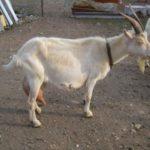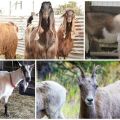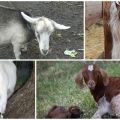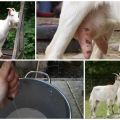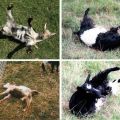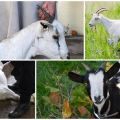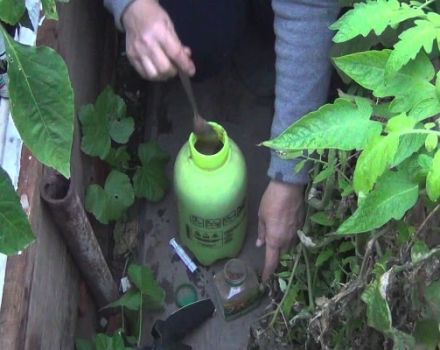What it can be if a goat has a lump on the neck and how to detect and properly treat
With proper care and a balanced diet, goats rarely get sick. However, they need a timely, thorough examination in order not to miss the onset of any disease or other problem. In particular, if a lump appears on the goat's neck, this may be the result of an injury to the animal, a symptom of iodine deficiency in the body, or a sign of a number of diseases that are dangerous even for humans.
Reasons for the appearance of cones in a goat
In adult animals, the causes of lumps on the neck are varied, including differing in the degree of danger to themselves and humans:
- inflamed injured places - goats in stalls can inadvertently run into a protruding nail or chips that have broken off from a wooden rack, in the pasture - pierce the skin with a branch, a metal rod. The infected wound becomes inflamed, filling with pus;
- diseases that provoke the appearance of formations - actinomycosis, caseous lymphadenitis, paratuberculosis, echinococcal cysts (the listed diseases are highly contagious, lead to the rapid infection of the entire livestock, and, in addition, are dangerous to humans);
- deficiency of iodine in the body - a constant lack of it in the diet leads to endemic goiter in animals. In adult goats, a visible enlargement of the thyroid gland occurs only in very advanced cases (they lag behind in growth, the skin suffers, milk yield decreases). From mothers who did not receive enough iodine during pregnancy, kids are born with small bumps on the neck, that is, with an already existing goiter. They often die shortly after birth.
Healthy kids under the age of four months, that is, during milk feeding, also develop milk goiter. It is more commonly seen in Nubian goats. The reason for the enlargement of the thymus in this case is unknown. Since the thymus gland is actively involved in the body's immune system, experts do not recommend treating babies in any way. After giving up breast milk, these formations dissolve on their own.
Detection methods
Even a healthy and vigorous animal with good appetite should be examined regularly and carefully. Under the coat, small bumps may not be visible at first, but the sooner the veterinarian determines the cause of their appearance, the faster the goat will be treated. What to look for:
- the location of the cone is on the side of the neck, bottom in the middle;
- whether hair is preserved on it;
- is it painful to touch the lump, pressure on it;
- are there traces of trauma - scratches, pricks, dried wounds.
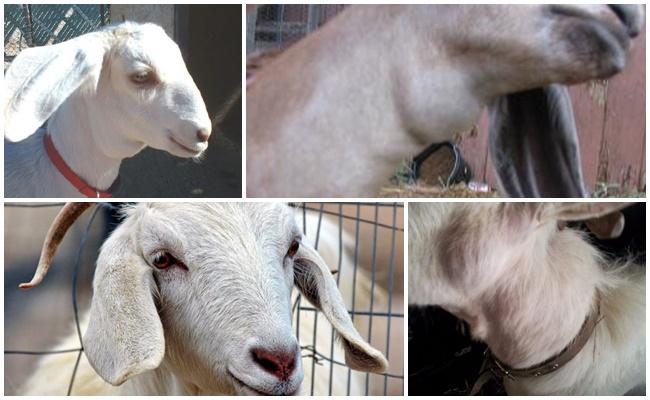
In any case, you should call a veterinarian to rule out dangerous diseases.If the behavior of the animal has changed or cones are found on the neck of a weak, unviable newborn kid, this should be done immediately (unlike a pathological one, milk goitre usually does not appear immediately, but some time after birth, sometimes after several weeks).
The more often the herd is examined, the easier it is to establish at what time the bump appeared. It is necessary to inspect the stall, make sure that there are no traumatic parts in it, and the grazing place must be checked in advance by removing dry branches and scrap metal from it.
How to treat correctly
It is advisable that the treatment of bumps on the goat's neck, which appeared for any reason, is carried out by a specialist veterinarian. If this is not possible, there is a high risk that the cause will be incorrectly established, and self-therapy will be ineffective. For infected wounds:
- large abscesses doctor of waters with local anesthesia opens, cleans, in advanced cases prescribes an antibiotic, choosing it depending on the state of health of the goat;
- small inflammations at home can be lubricated with Vishnevsky's ointment, and after the abscess breaks through, rinse the wound with hydrogen peroxide and put a piece of bandage with levomekol into it, constantly changing it.

If the wound does not improve, you should see your doctor for antibiotics. The consequences of chronic iodine deficiency are easier to prevent than to cure. The use of iodized commercial salt is not enough. We need veterinary drugs - "Sedimin", "Yodomidol", "Kayod" and others. Their number and frequency of use is calculated by the veterinarian based on the weight and condition of the animal. Goats need to get them during pregnancy, along with balanced micronutrient feeds.
The possibility and procedure for treating infectious diseases is determined by the doctor:
- with actinomycosis, the veterinarian opens abscesses, removes pus, injects antibiotics, sulfa drugs;
- cystic echinococcosis, depending on its type, is treated percutaneously, surgically or with anti-infective drug therapy;
- there is no treatment for caseous lymphadenitis; in industrial animal husbandry, sick animals are discarded, and their carcasses are disposed of. In home breeding, if an individual is of emotional value, it is isolated, antibiotic therapy is given, and the encapsulated abscesses are opened, cleaned of the contents and disinfected.
Therapy for these diseases is always long-term, but not always effective.
Potential danger
In the absence of timely treatment, purulent abscesses in a goat can break through and clear themselves, or they can burst inside and lead to sepsis of the animal and its death.
Iodine deficiency leads to a variety of animal health problems:
- in goats, the cyclicity of estrus is disturbed, fertility and fertility are reduced;
- often occurs fetal resorption, miscarriages at the beginning of pregnancy, abortions, the birth of non-viable kids;
- milk yield and fat content are falling.
The surviving young, born with goiter, have a slower increase in live weight. To prevent pseudotuberculosis, echinococcosis and any other infectious diseases, a person should strictly adhere to personal prevention measures while caring for animals. If you suspect them, you must immediately isolate the individual from the rest of the herd and immediately contact the veterinarian for the necessary analyzes of the contents of the cones.

